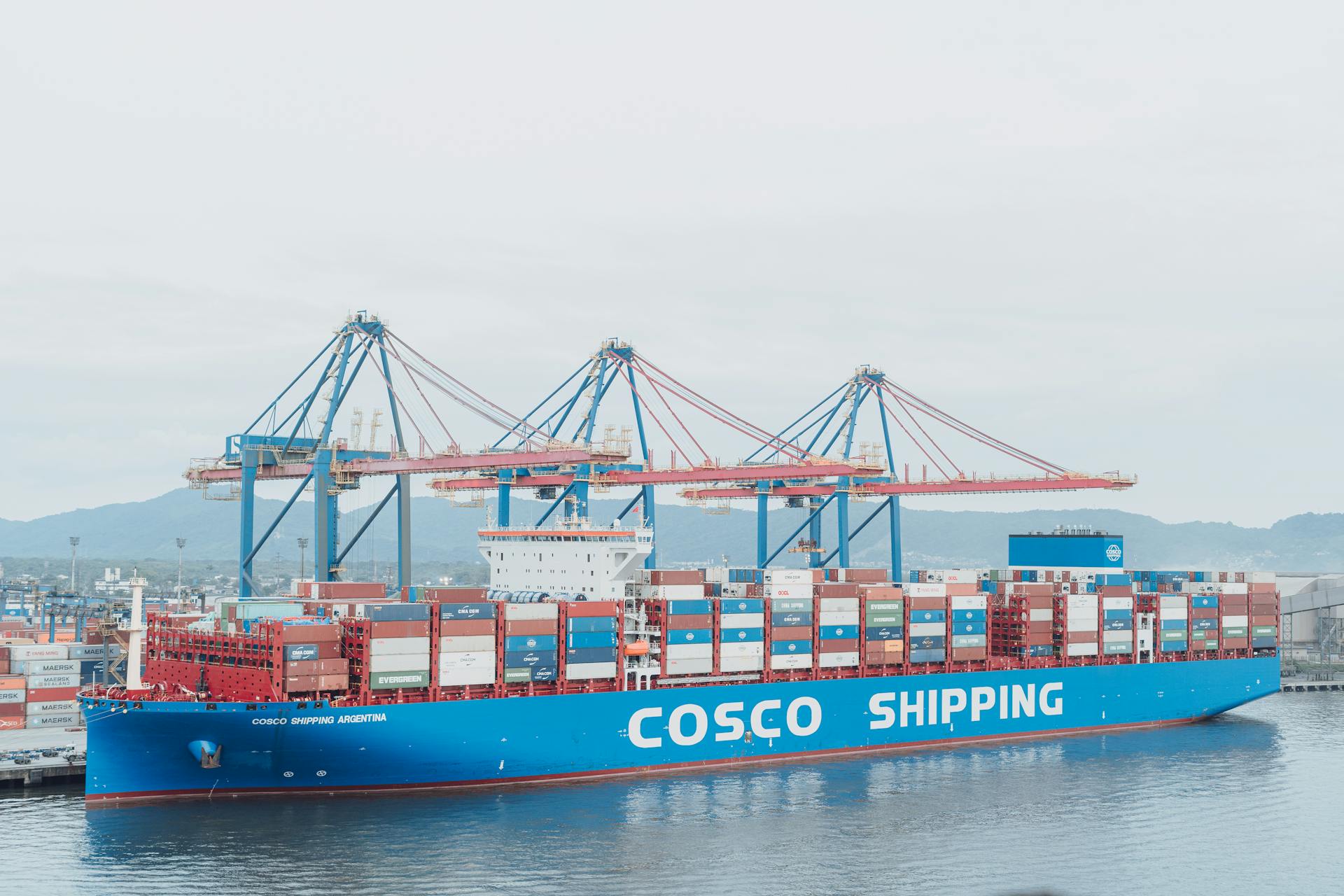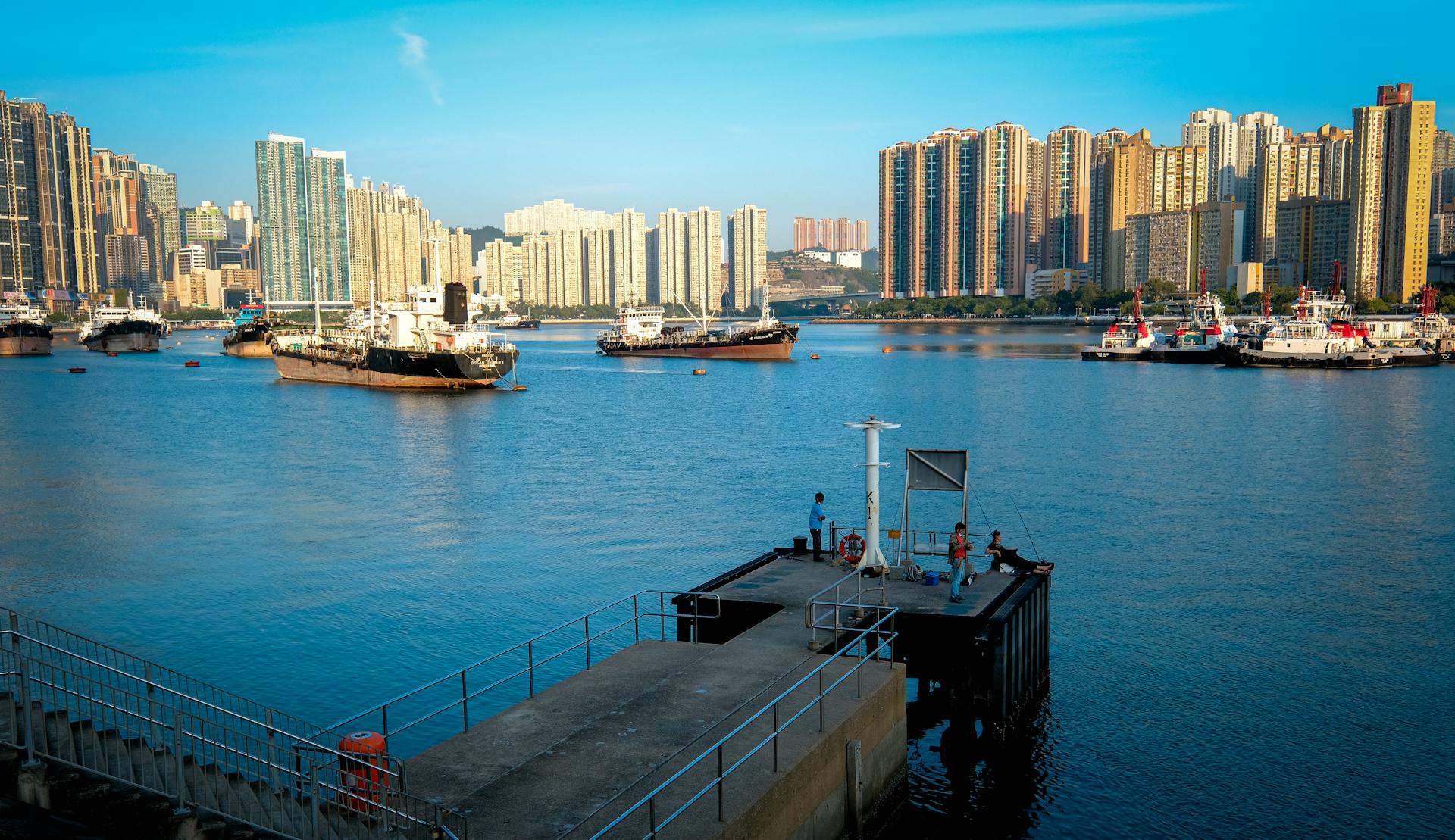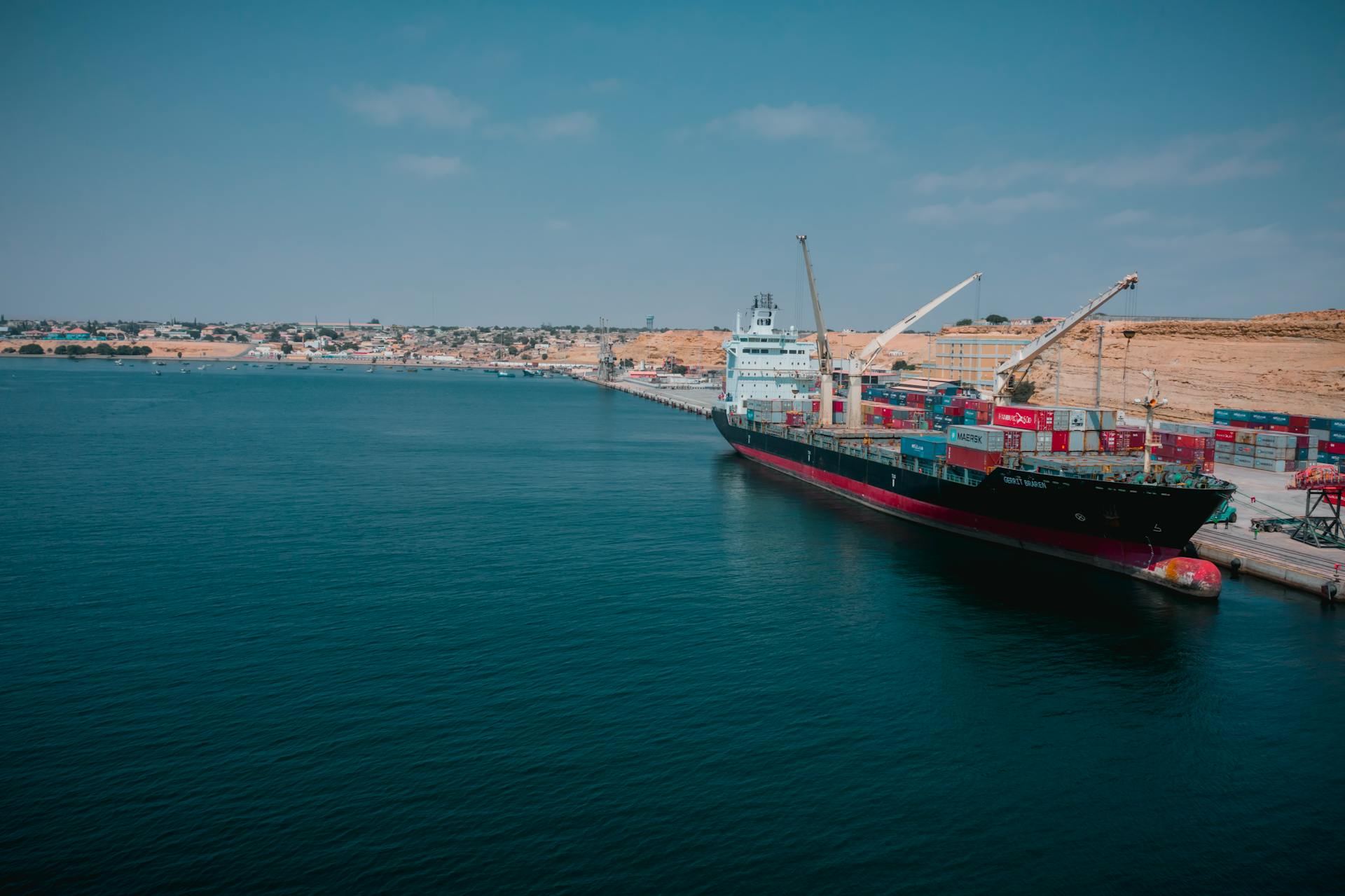
Cosco Shipping Ports Peru is a significant player in the Peruvian port market, with a growing stake in the country's infrastructure.
The company has been expanding its presence in Peru, with a focus on increasing its market share.
Cosco Shipping Ports Peru has made strategic investments in various Peruvian ports, including the Port of Callao, which is one of the country's busiest ports.
This expansion is expected to enhance the efficiency and capacity of Peruvian ports, benefiting both local and international trade.
History of Cosco Shipping in Peru
In 2007, former Peruvian Navy Admiral Juan Ribaudo de la Torre conceived the construction of a substantial commercial port south of the historic Chancay Marina.
The Chancay Harbor Company was established to supply the necessary land for the project, and later, in 2011, Ribaudo and his business collaborated with Volcano Mining Peru to advance the port project.
The involvement of Volcano Mining and COSCO Shipping in 2019 facilitated the reconstruction and expansion of the project, with a total expenditure anticipated to reach $3 billion.
COSCO Shipping Ports acquired a 60% stake in the project, and the company was renamed from Chancay Port Terminals to Cosco Shipping Ports Chancay Perú S.A.
The first stage of the port was finished by the end of 2024, and the port was inaugurated on November 14, 2024, in a ceremony attended online by Chinese leader Xi Jinping and Peruvian president Dina Boluarte.
This marked a significant milestone for COSCO Shipping in Peru, with the launch of trial operations at the Chancay Port, a modern gateway that promises to revolutionize shipping logistics between the region and key markets like China.
Cosco Shipping in Peru
COSCO Shipping has made a significant investment in Peru, acquiring a 60% stake in the Chancay Terminal for $225 million. The terminal is located at Chancay Harbor, a natural deep-water harbor with a maximum water depth of 16 meters.
The Chancay Terminal is strategically positioned near Lima, Peru's capital city, and is connected to the economic center of Peru by convenient traffic. It's a key hub for trade between Peru and China, and between China and Latin America. COSCO Shipping plans to build the terminal into a major gateway port in Peru.
COSCO Shipping's investment in Chancay Terminal is part of its efforts to extend its reach to South America and help cut Peru's deficiency in port infrastructure. The terminal will have a total annual designed capacity of one million TEU, or twenty-foot equivalent units, with four berths, including two multipurpose berths and two container berths.
Capacity
The port of Chancay is a significant player in Peru's shipping industry, and its capacity is impressive. Around one million containers can be handled per year in the first expansion phase.
The port's natural draft of 17.8 meters (58.4 feet) makes it an attractive option for vessels of all sizes. Its strategic geographic position on Peru's central coast is also a major advantage.
The initial phase will comprise four jetties with a length of 400 meters, which will enable the port to accommodate a large number of vessels. This will be a game-changer for cargo transportation in the region.
The port project is designed to facilitate the transportation of about 1 million TEUs and a total of 6 million cargo items annually. This is a huge undertaking that will have a significant impact on the local economy.
Business Structure
The business structure behind the harbour project in Peru is quite interesting. China is building the harbour as a gateway to South America due to its interest in the continent's resources.
Peruvian mining company Volcan will own a 40% share of the company, while COSCO Shipping will hold the remaining 60%. This partnership has sparked controversy in Peru regarding Chinese influence.
The Peruvian Congress has passed a law granting COSCO Shipping exclusive use of the port, which has raised concerns about the impact of Chinese investment on the local economy.
Xi Jinping has stated that the port is expected to generate $4.5 billion annually and create 8,000 jobs, which would be a significant boost to the local economy.
Chinese Firm Acquires Peru Port Stake
The Chancay terminal is located at Chancay Harbor in central Peru, about 58 kilometers from Lima, the country's capital.
COSCO Shipping Ports Ltd acquired a 60% stake in the terminal from Volcan Compañía Minera SAA for $225 million, with an initial payment of $56 million.

Chancay terminal is a natural deep-water harbor with a maximum water depth of 16 meters, capable of meeting the needs of mega vessels.
It will have four berths, two multipurpose and two container berths, with a total annual designed capacity of 1 million TEU.
The terminal is expected to become a major gateway port in Peru, facilitating trade between Peru and China, and between China and Latin America.
COSCO Shipping Ports' terminal portfolio covers five main port regions, and by the third quarter of 2018, it operated and managed 282 berths at 36 ports worldwide.
The Chancay terminal is designed to cut Peru's deficiency in port infrastructure, and will help reduce transit times between Peru and China to just 23 days.
The terminal is expected to create jobs, services, and infrastructure investment opportunities, and will be a key hub in South America, the most important logistics center on the Pacific coast.
Cosco Shipping in Peru
Cosco Shipping in Peru has made significant strides in recent years. The company acquired a 60% stake in the Chancay Terminal from Volcan Compañía Minera in early 2019 for $225 million.
COSCO Shipping Ports Ltd has invested heavily in the Chancay Terminal, which is strategically located at Chancay Harbor in central Peru, about 58 kilometers from Lima. The terminal boasts an exceptional geographic location and is connected with the economic center of Peru by convenient traffic.
The Chancay Terminal has a maximum water depth of 16 meters and is capable of meeting the needs of mega vessels. It features multipurpose terminals, container terminals, and related infrastructure facilities.
Phase one of the terminal will have four berths, of which two are multipurpose berths, and two are container berths with a total annual designed capacity of one million TEU. This will enable the company to further extend its reach to South America and help cut Peru's deficiency in port infrastructure.
The Chancay Terminal is poised to become a major gateway port in Peru, facilitating trade between Peru and China, and between China and Latin America. It will create jobs, services, and infrastructure investment opportunities.
COSCO Shipping's investment in the Chancay Terminal has been a milestone for the company, marking its first green and smart port investment in South America. The terminal has been designed for a throughput capacity of 1 million TEUs, 6 million tons of bulk cargo, and 160,000 vehicles annually.
The Chancay Port has integrated intelligent loading and unloading equipment, with pure electric container trucks alone contributing to a decrease in energy consumption of over 25%. This is a significant step towards green, low-carbon growth.
COSCO Shipping has launched trial operations at the Chancay Port, which promises to revolutionize shipping logistics between the region and key markets like China. The port is set to reshape trade routes, slashing transit times and offering innovative solutions that align with evolving industry needs.
The transit time between Peru and China has been reduced to just 23 days, benefiting time-sensitive shipments like fresh produce. This means faster delivery to market shelves, ensuring peak quality and competitiveness.
COSCO Shipping has also issued the first-ever Chancay electronic bill of lading (eB/L) at Xiamen Port, enhancing operational transparency and streamlining documentation. This digital service is a crucial step towards digitizing the supply chain.
Cosco Shipping Milestones
Cosco Shipping has a long history of milestones that have shaped the company into what it is today.
The company was founded in 1961 in China.
In 1997, Cosco Shipping acquired the Hong Kong-based shipping line, Orient Overseas Container Line (OOCL).
Cosco Shipping has a significant presence in Peru, with a major shipping hub at the Port of Callao.
Cosco Shipping's fleet has grown to over 1,000 vessels, making it one of the largest shipping companies in the world.
Cosco Shipping has been investing heavily in digitalization and technology, including the use of big data and artificial intelligence to optimize shipping routes and schedules.
Cosco Shipping in Peru
Cosco Shipping in Peru is a significant player in the region's logistics industry. The company acquired a 60% stake in the Terminales Portuarios Chancay SA for $225 million.
COSCO Shipping Ports Ltd has reached an investment agreement with Volcan Compañía Minera SAA to acquire the stake. The remaining 40% stake is owned by Volcan. The deal was sealed in Davos, Switzerland, with an initial payment of $56 million.

Chancay terminal is strategically located at Chancay Harbor in central Peru, about 58 kilometers from Lima. It's a natural deep-water harbor with a maximum of 16-meter water depth. The terminal boasts an exceptional geographic location, connected with the economic center of Peru by convenient traffic.
The construction of Chancay terminal includes multipurpose terminals, container terminals, and related infrastructure facilities. Phase one of the terminal will have four berths, of which two are multipurpose berths, and two are container berths with a total annual designed capacity of one million TEU.
COSCO Shipping Ports and Volcan can fully utilize their resources and capabilities to jointly build Chancay terminal into a major gateway port in Peru. This will facilitate trade between Peru and China, and between China and Latin America while creating jobs, services, and infrastructure investment opportunities.
The Chancay Port, strategically located along Peru's coastline, positions itself as a critical node for West South America. It's set to reshape trade routes, slashing transit times and offering innovative solutions that align with evolving industry needs.
The reduction in transit time between Peru and China to just 23 days is a significant improvement that benefits time-sensitive shipments like fresh produce. This means faster delivery to market shelves, ensuring peak quality and competitiveness.
COSCO's issuance of the first-ever Chancay electronic bill of lading (eB/L) at Xiamen Port enhances operational transparency and streamlines documentation, cutting down traditional paperwork bottlenecks.
The Chancay Port is designed for a throughput capacity of 1 million TEUs, 6 million tons of bulk cargo, and 160,000 vehicles annually. It features storage yards, warehouses, and multi-purpose logistics areas, with a 1.8-kilometer tunnel connecting the port to the Pan-American Highway.
The port has integrated intelligent loading and unloading equipment, with pure electric container trucks contributing to a decrease in energy consumption of over 25%.
Sources
- https://en.wikipedia.org/wiki/Port_of_Chancay
- https://www.chinadaily.com.cn/a/201901/25/WS5c4a6594a3106c65c34e6744.html
- https://breakbulk.news/cosco-shipping-marks-milestone-with-chancay-port-operations-in-peru/
- https://www.offshore-energy.biz/cosco-shippings-green-and-smart-terminal-in-peru-begins-operation/
- https://www.porttechnology.org/news/cosco-shipping-chancay-peru-terminal-begins-operations/
Featured Images: pexels.com


